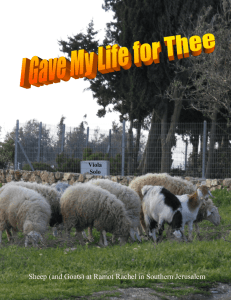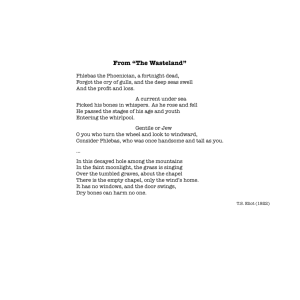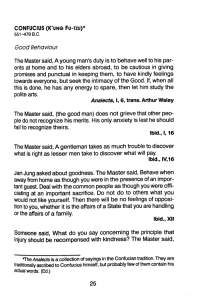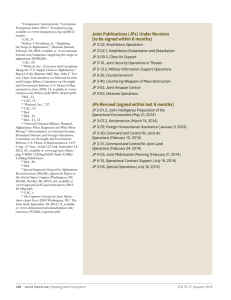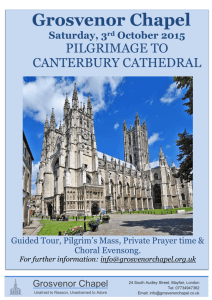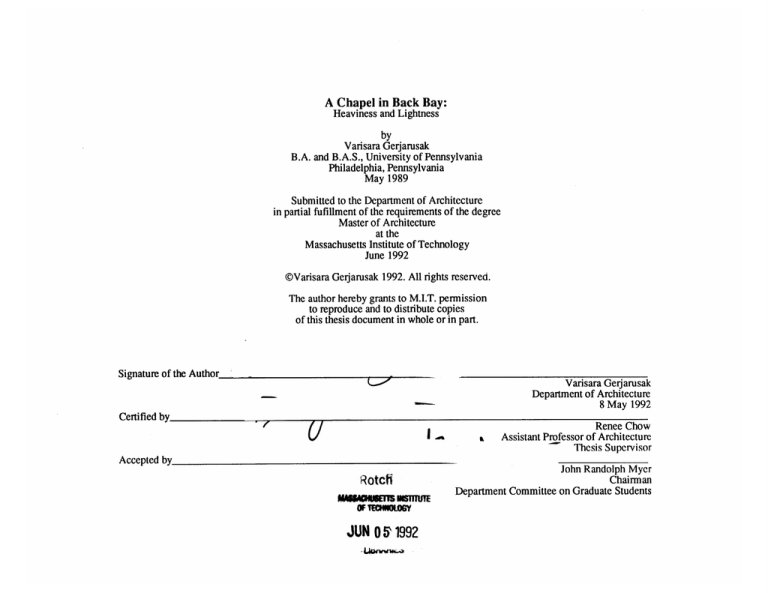
A Chapel in Back Bay:
Heaviness and Lightness
by
Varisara Gerjarusak
B.A. and B.A.S., University of Pennsylvania
Philadelphia, Pennsylvania
May 1989
Submitted to the Department of Architecture
in partial fufillment of the requirements of the degree
Master of Architecture
at the
Massachusetts Institute of Technology
June 1992
@Varisara Gerjarusak 1992. All rights reserved.
The author hereby grants to M.I.T. permission
to reproduce and to distribute copies
of this thesis document in whole or in part.
Signature of the Author____________________
Varisara Gerjarusak
Department of Architecture
8 May 1992
Certified by
Sdf
Accepted by
l
Renee Chow
Assistant Professor of Architecture
Thesis Supervisor
John Randolph Myer
Rotch
Chairman
I
Wk
OF TEOi0LOGY
JUN 05 1992
- Laoru "
.
S9Department
Committee on Graduate Students
To my parents, with love
Deepest
Thanks to:
Renee Chow
Jim Axley
Shun Kanda
for their guidance, support,
and encouragement
To:
my brothers Sarakom
and Saravut
for always being there for me
And to:
all my friends
for their caring and support
4
Contents
Abstract
7
Preliminary Studies
9
- Inspirations: visual references
11
- Heaviness and Lightness: diagrammatic study
18
2
Program and Site
23
3
Concepts
27
1
- Concept Design 1
- Furness and Scarpa: case studies
28
32
- Corners
34
- Courtyards
- Concept Design 2
4
37
43
- Concept Design 3
46
Design: a Journey
49
Notes
Illustration Credits
Bibliography
86
87
90
A Chapel in Back Bay:
ABSTRACT
Varisara Gerjarusak
This thesis chronicles a design
process of a chapel in Back Bay,
Boston. The first three sections
record a juxtaposition of short
studies and concept designs while the
last focuses on the design
development of the chapel alone.
Heaviness and Lightness
Submitted to the department of
Architecture on May 8th, 1992
in partial fulfillment of the
requirements for the degree of
Master of Architecture
Heaviness and lightness are the
inspiration for this thesis. I have
come to understand the words less in
terms of their conventional
meanings and more of a dialogue
between ranges of architectural
forms which complement one
another. An experience of a place
can be enhanced by thoughtful
interplay of these two qualities.
Through the specific site and story
can these qualities be deployed in a
meaningful manner.
Thesis Supervisor: Renee Chow
Title: Assistant Professor of
Architecture
1 Preliminary Studies
Cultivate the heart and quite the
intellect,
Thus the Way may be obtained.
The Way cannotbe expressed by
the mouth,
Seen by the eye nor heardby the
ear.
It is the means to cultivate the
heart so as to rectify forms.1
Kuan Tzu (645 B.C.)
Inspiration:
Visual References
4) ~
~>'i
0il
I
The fragile wooden posts and
delicate ornamental details of
vernacular That architecture have
always astonished me. Boston
architecture is of equal interest
for quite different reasons: its
impressive bulk and weight.
Richardson's massive stone
arches and 348 Beacon Street's
robust terra-cotta ornaments can
be just as exciting in another
way. I chose to explore these
two worlds. I wish to articulate
the qualities of these
complementary forms to enhance
an experience of architecture.
The following six pages contain
series of images arranged into a
pattern which describes visually
my initial impression of the two
qualities.
( Excerpt from Italo Calvino's Six
Memo for the Next Millennium,
chapter 1: Lightness )
I will devote my first lecture to the
opposition between lightness and
weight, and will uphold the values
of lightness. This does not mean
that I consider the virtues of weight
any less compelling, but simply
that I have more to say about
lightness.
After forty years of writing fiction,
after exploring various roads and
making diverse experiments, the
time has come for me to look for an
overall definition of my work. I
would suggest this: my working
method has more often than not
involved the subtraction of weight.
I have tried to remove weight,
sometimes from people, sometimes
from heavenly bodies, sometimes
from cities; above all I have tried to
remove weight from the structure
of stories and from language.
I
In this talk I shall try to explain both to myself and to you - why I
i~
have come to consider lightness a
1
2
3
4
House along a river in Thailand
Scarpa's pavilion
Wooden shutter of a house in Thailand
Pavilion in Ayudhaya, Thailand
3
value rather than a defect; to indicate
the works of the past in which I
recognize my ideal of lightness; and
to show where I situate this value in
the present and how I project it into
the future...
..
...The only hero able to cut off
Medusa's head is Perseus, who flies
with winged sandals; Perseus, who
does not turn his gaze upon the face
of the Gorgon but only upon her
image reflected in his bronze shield.
Thus Perseus comes to my aid even
at this moment, just as I too am about
to be caught in a vise of stone which happens every time I try to
speak about my own past. Better to
let my talk be composed of images
from mythology.
To cut off Medusa's head without
being turned to stone, Perseus
supports himself on the very lightest
of things, the winds and the clouds,
and fixes his gaze upon what can be
revealed only by indirect vision, an
image caught in a mirror...
I?:
...The relationship between Perseus
and the Gorgon is a complex one and
does not end with the beheading of
1
2
3
4
H.H. Richardson, Hayden Building, Boston
L. Sullivan, The Auditorium Building, Chicago
F. Furness, Pennsylvania Railroad Station
Scarpa, wall texture of Castelvecchio Museum
the monster. Medusa's blood gives
birth to a winged horse, Pegasus the heaviness of stone is
transformed onto its opposite...
...Whenever humanity seems
condemned to heaviness, I think I
should fly like Perseus into a
different space. I don't mean
escaping into dreams or into the
irrational. I mean that I have to
change my approach, look at the
world from a different perspective,
with a different logic and with
fresh methods of cognition and
verification. The images of
lightness that I seek should not
fade away like dreams dissolved by
the realities of present and future...
...From what I have said so far, I
think the concept of lightness is
beginning to take shape. Above all
I hope to have shown that there is
such a thing as a lightness of
thoughtfulness, just as we all know
that there is a lightness of frivolity.
In fact, thoughtful lightness can
make frivolity seem dull and
heavy.
1 Horizontal trap for snake-head fish from the
central region of Thailand
2 Scarpa, roof detail from Castelvecchio
Museum
3 Fumess, interior of a bank in Philadelphia
4 Scarpa, bridge detail from Castelvecchio
Museum
A f.
....
........
I could not illustrate this notion
better than by using a story from the
Decameron (VI..9), in which the
Florentine poet Guido Cavalcanti
appears...
...Were I to choose an auspicious
image for the new millennium, I
would choose that one: the sudden
agile leap of the poet philosopher
who raises himself above the weight
of the world, showing that with all
his gravity he has the secret of
lightness, and that what many
consider to be the vitality of the
times
-
noisy, aggressive, revving
and roaring...
2
...In short, in every case we are
concerned with something marked
by three characteristics; (1) it is to
the highest degree light; (2) it is in
motion; (3)
itisavector of
information...
...We might say that throughout the
centuries two opposite tendencies
have competed in literature: one tries
to make language into a weightless
element that hovers above things like
3
1 F.L. Wright, interior of the Imperial Hotel,
Japan
2 F.L. Wright, a house
3 F.L. Wright, the City National Bank and
Hotel, Iowa
4 F.L. Wright, wall detail, Imperial Hotel
a cloud or better, perhaps, the
finest dust or, better still, a field of
magnetic impulses. The other tries
to give language the weight,
density, and concreteness of things,
bodies, and sensation...
I have spoken of the shaman and
the folktale hero, of privation that
is transformed into lightness and
makes possible a flight into a realm
where every need is magically
fulfilled. I have spoken of witches
flying on humble household
implements, such as a bucket. But
the hero of Kafka's story doesn't
seem to be endowed with the
powers of shamanism or
witchcraft; nor does the country
beyond the Ice Mountains seem to
be one in shish the empty bucket
will find anything to fill it. In fact,
the fuller it is, the less it will be
able to fly. Thus, astride our
bucket, we shall face the new
millennium, without hoping to find
anything more in it than what we
ourselves are able to bring to it.
Lightness, for example, whose
virtues I have tried to illustrate
here. 2
1 Fishing traps and equipments from Thailand
2 Decorative detail of a roof, Thailand
3 F. Furness, detail of roof truss, University of
Pennsylvania Library, Philadelphia
4 Siren, detail of roof truss of a chapel in
Finland
"Semper was to divide built form
into two separate material
procedures: into the tectonics of the
frame in which members of varying
lengths are conjoined to encompass a
spatial field and the stereotomics of
compressive mass that while it may
embody space, is constructed
through the piling up of identical
units... These are gravitational
opposites, the immateriality of the
frame and the materiality of the
mass...
..It is arguable that the practice of
architecture is impoverished to the
extent that we fail to recognise these
transcultural values and the way in
which they are intrinsically latent in
alll structural form.
-mu"a
3
...As we have already indicated, the
tectonic lies suspended between a
series of opposites.... Dialogical
conditions are involved in the
articulation of tectonic form,
particularly the contrast between the
culture of the heavy - stereotomics,
and the culture of the light tectonics. The first implies loadbearing masonry and tends towards
the earth and opacity. The second
implies the dematerialised a-frame
and tends towards the sky and
translucence..."3
Kenneth Frampton. Rappel a l'ordre.
1, 2, and 3 My old projects
Heaviness and Lightness:
a diagrammatic study
These visual references have
been arranged into eight related
series and abstracted the qualities
immediately felt in each into
relief diagrams of plain
cardboard and tiny plastic beads.
Together the series create a
matrix of how heavy and light
forms might be juxtaposed with
one another.
However, this matrix is far from
being complete. It only suggests
a way of organizing my
perception as well as
communicating my idea to the
others. The generalization of
cardboard surfaces as heavy and
rows of clear plastic beads as
light with some yellow beads as
in-betweens is a crude
representation, for the range from
heavy to light can be much more
delicately depicted. Nevertheless,
these abstract diagrams begin to
describe something beyond the
visual qualities of the images.
I rarely think in words at all
--Einstein
1 Children under straw pavilion
2 Sleeping worker, St. Thomas Cathedral.
Bombay
Light as bearing, supporting more
solid structures above.
3 Buildings on piers in Britain
4 Buildings on piers in Britain
Heavy structure rises up from the
ground while lighter structure above
alows itself an opportunity to be
open or closed.
5 A building by F.L. Wright
Transformation of heavier structure
below to lighter structure structure
above.
2
6 Painting of an unknown building
9-
'CC
.411
lk
tI
Solid panels stop light while screens
offer continuous light. They are
layered side by side.
1 Exterior of a shrine in India
2 Interior of the same builing
Layering of a more permeable
surface to a more opaque one from
outside towards inside.
3 Chinily Kiosk, Istanbul
4 Interior promenade of a building in India
Stone arch spans the structure across
while resists load under compression.
5 F. Furness, Pennsylvania Railroad Station
8
Steel truss span the roof across as
well as allows light to enter the
building from above.
6 Berlager, Stock Exchange, Amsterdam
Heaviness as bearing and lightness as
spanning. They are independent of
their materials.
7 Cathedral at Burgos, France
8 F.L. Wright, Falling Water, Pennsylvania
"...How carefully is the elusive
hidden that we often have to imagine
what lies behind screeneddoors..."5
"..Jt is a strong wall,flat but for
regularpunctures.
A stone wall in the cradleof God's
finger, into which one's spiritmay
find the presence of sanctuary and
rest."6
Kevin Low
2 Program and Site
The Site
The site is located at the
intersection of Marlborough and
Berkeley streets. It is in the Back
Bay area where buildings of
various uses display a degree of
environmental homogeneity. The
regularity of the fabric pattern
allows for some alien architectural
vocabulary to be actively
introduced and vitally engaged.
I
Af
r§443r
iWn
OS
r9
:I.r-,1.
-9r,9tzLL
9
r
to
I
View of the First Lutheran church opposite to
site on Berkeley Street.
NOISOB
N
2
Marlborough
Site Plan
1
Street
NI
O
Q~9'6V
to
N
LL 'h
11
The Program
The chapel will encourage a sense of
community and religious awareness
which corresponds to different levels
of engagement ranging from secular
public gathering to private individual
contemplation. Space for secular
activity is provided on the ground
level where it is hoped that much of
the casual interaction will take place.
The main gathering room, located on
the upper level, accommodates
different religious activities such as
private worship, choir group
meetings, and wedding ceremonies.
A small courtyard, protected from
the outer world by walls of varying
thicknesses, separates the chapel
from the offices and the reading
room. The permeability of the
chapel's ground level suggests a flow
of activity into the courtyard area,
while the upper level is very much
enclosed by solid walls which only
open up to the sky.
2
1 View along Marlborough Street, opposite to
site
2 View along Marlborough Street, on the same
side as site
h
"..And yet architectureis not
reducible to materials,making,
building, environment, needs, and
socialenterprises...We do not see
architectureas a system of
precedents,but ratheras systems of
forms, received and invented, that
must be understoodin the complex
relationsof theirmaking and use..."
Standford Anderson (1992)
3 Concepts
Concept Design I
1.. Study on Marlborough Street edge condition.
Original: casted plaster at 1/2" scale
2 Sketch model
Original: cardboard and clay at 1/32" scale
3 Sketch model
Original: bass wood and chip board at 1/32"
4 Sketch model
Original: metal screens and pins at 1/32"
(page 30 and 31)
5 3/32" site plan
6 Blown up detail of site plan
.........
......
.
...
A
% 4zv~
:*KlK......
..........
s
...........
....
....
.....
.s
X-$2M
.....
. .. ,..
. . . . . . . . . .. .. . . . . . .
9X
......
a.
.......
-..
-..-
........
-
.. . .. ..
4
. .. .
--.....
-.
.
-..
.
..
......
IB
I
N.
x$
Furness and Scarpa:
Case studies on details of
Pennsylvania Academy of Fine
Arts and Brion Pavilion.
In the work of CarloScarpa
"Beauty" thefirst sense
Art
the first word
Then Wonder
Then the innerrealizationof
"Form"
the sense of the wholeness of
inseparableelements.
Design consults Nature
to give presence to the elements.
A work of art makes manifest the
wholeness of "Form"
the symphony of the selected
shapes of the elements.
In the elements
the joint inspiresornament, its
celebration.
The detail is the adorationof
Nature.7
Louis I. Kahn
(What Will Be HasAlways Been)
"...this is not decorative excess for its
own sake. Each detail is used to
enhance, accent, and differentiate,to
create spatialflow and unity. These
are tools manipulatedwith full
awareness..."a
Ada Louise Huxtable
(Note of Furness)
51
The shift in the support axis is
contradictory to the nature of the
structure. However, both architects
have made the decision as a tradeoff for the territory gained by such
action. In Scarpa's Brion Pavilion,
the territory between the roof and the
floor is divided into two portions, the
larger defined by the longer member
which belongs to the roof while the
smaller is defined by the shorter
member which belongs to the floor
below. Similarly, in the Academy of
Fine Arts, the territory underneath
the smaller arch receives the landing
of the stair while the one underneath
the larger suggests the spatial flow of
the room beyond.
1 Furness and Hewitt, Column detail,
Pennsylvania Academy of Fine Arts,
Philadelphia, 1871.
2 Carlo Scarpa, Column detail,
Brion Pavilion,
Treviso, 1969.
Corners
This is a diagrammatic note on the
interplay of solid, continuous
surfaces and discrete, screen-like
elements at the intersection of
Berkeley and Marlborough Streets
The diagrams start from a typical
continuous L-shape corner which
gradually transforms into more
discrete pieces of walls and
columns.
..
..........
...
....
...........
.....................
.
Three 1/4" models of the same
corner have been made to study
three-dimensionally different ways
in which materials are put together
to create similar corner forms.
Without really having a clear
picture of the overall organization
of the plan, I have chosen to start
with the design of this particular
corner of the building. The later
development of the plan has grown
from this corner study/design.
Thus, this exercise touches on the
issue of heaviness and lightness as
well as offers the possibility of
further design exploration.
'''It
Courtyards
The form of a courtyard is interesting
because it articulates an interplay of
permeable surfaces of the inner core
and more solid, opaque surfaces of
the outer perimeter.
Looking at a selection of courtyardbuilding plans, I arrange them into a
series ranging from the most
conventional to the more
transformed. Diagrams
corresponding to each plan are later
drawn to describe abstractly the
process of transformation and
elements found consistent in the
courtyard .
Finally, Aalto's Malm Funeral
Chapel is described in terms of these
different elements constituting the
courtyard form.
1 Jahangir Manal, India
First floor plan
2 L'Hopital, Rhodes, France
Plan of Rez-de-Chaussee
3 Bayt al Ghanim, Kuwait
plan
4 Bayt al Badr, Kuwait
plan
(page 40)
5 Alvar Aalto, Malm Funeral Chapels
Helsinki, roof plan
6 Malm Funeral Chapels, first floor plan
rim
10
2
-..
39
".X.....-
lowo
L.
LE
-
ii
..
[7 ..
R
.......
-.......
Concept Design II
1 Study with site model
Original: cardboards and paper at 1/32" scale
(page 44 and 45)
2 Study of plan
Original: clay and wire at 1/16" scale
3 Study of plan
Original: prisma color drawing at 3/32" scale
.
*i
..
I
...
,:,,.,:
....
..
..
....- ....
..,
.... .. .
....
iiiii:: ",
"
:
i i
i:i
i i;i
,.:.:
iI.....,
I
..
. :i:..I.i:i:
:i:::::::i:::::::i:::i:::::::::
-. ; ...
:.:.:.:
i*i*i*§
,
iii:ii
.. .
....
,11
-""""'.
".....
.1
..
...
..*
-............
....
...
*'**
......
"
**'
"'*"""'*"""'*"'*'*'*""*",
.,-,-.-.....--...-.-
-.. :.
.::::::-:i:::i:::'..:
::::::i:
:j:j:j:
:j:j:
::;:i*i:i:i
:j:j:
..
.:i:::::::::i:::i::::
. . . . .
.. ,-.
....
.......
.......
:-:":-!-,-...........:.;
...
OXI
. - ....
.1 1
......
i::
::%,:::Z
:..........
... .....
:.sN ,.W. *:::,
.
........
.
.:.
- .:
-:j:
-
:,....:r.........,..,..:"
.
i
i:
ii:
.............
i..v:l
.........
::...
i: -,*',
.::iii:i§i:i::::ii
:
j:*.
:j,*.::j:
..........
::::::
-,-:-:-:.
......
%
..
*.
I
:
:
j
.
:
..
:
,:
..,.:
'
.
1-
:.::
....
-
I
1,.
I
': -
:,-:::
.,:.;.::
....
"I
w
.:.:.::
. .
.
....
I.
.
.
.
.
......
...-.
.....
;::,.
.........
:
,iiii
iiiii::
i: i:i...
i:
:iiiiii
i ,i:i:
i i:i,%*.i
::
::,
..
I
.
.
iii:ii
:
i :i:i
:,.:..,.:.::i:i:
i
i.
..
.. :
..
,.l.
. I
:j:j:
:j:j:
::.-
:
..
:::i:i:i,:,:,:.::::
I
:
....
.
- I
..
i.E.i:.:
"
"
.'.
I
:i:j:j:j:j:
;
.:.:.
........
....
.:
:,.:
*
-
.
...
I,:
*
.
':
:i
';.:'*
X
:
i!i:;..
,;.i
.':..:.:i]:
I
.:iI..
;::I.I1
I'.:"
.:,::iI
:i.*
*
i
:::..
..........................
.
::!
.
:: ,:.::.*.,.
I
ii
..-.--:..........
:,,
........
I
"I
::i
...
;.:
..
.
I
1
...............
...
.
... ..
..
....
;;;;
::*
.......
.
..: .
.: .
I. II
....
: ::::...,.....:::.
'. ,.-.:-.,
:.
.1. I
i*::
..............
:::j:j:::
i.. :j::::::%j:j::
j:::j:j:::::j:]:
. :
.
iiiiiii:!:iii
..
- "
I-
:
:
.:.:.:.
,*:::.:-X::-:-:.
.
.,
"
;
:i:::i:!:
I
:.:.:,.
:j:j:j:
"..- .:,
."
$i,X
-.:..I
..:
:
:.
.:,..:-..I..
,.II1
::i:.I-iA
.
;*j*.,.j
.I:X
.C
-:.i.:"
.':.
:.-j:-I
.
:'I..,I.w
"
-:
.i:-,I.j
,.-"
I-:,
.....
O' , ..
:....:
-,
I
I
...
. .
....
. "..*!, -....",..--... - - ... :::% . ., 7r.;-ii."V:.I,I:-ii!:*,.:J:.!-iil,II
....
.-111.
.1.
I.. .- ..::,.1 .- I
I
I
11
11
...
-.-1.,1.
:----I I1 II1.1
j
'
.
....
-I.X.
,
.....
..
,
4
..:.'.'.
..........
*.§:"
I: ..-I: . X
'!?1:.',.!:i:--A.'
- .......-',..I. ...,..,:;::::
......:.,.
-e**'"*
ii... . . . ........-......-..
""
, . :.-.-.-.-,-..
::,-:;;
Iilr.%
...
.,',iii,-N
.ijl::.':::K,::i:;
:: ,
.
.*..
'I.,
-....
1-1- 1 -- . . , .,.::.:1:5*.1
.- . ..
11
I
,
.
X
..
/
-i.I
:...;..-:
.
...
,.,-;
.....
:...
I
..,
.
1-",;.I-i:Il'
..
:",:% : : :,
:
.,
' '
:.:.:
,
::
.
..
iiii i:iiii "
......
I.
1. ..
,.
'1.
.:,.
I
"I
k.
,:I
',.
"
.
...
.'.
11
11
::i:...........................,..,
.-
...
.
...-....-..
I.
11-11-1-1.1.1
;
. ,.'
.:
,
.. :..
.... : i i.
,
,
.-
I
I
"I'll..
,.,..
.eI. . :,.
I
.....
: I
I
...
.
.:,.
'.
.. ..... .. . .
i.i:
:i:::
::
,
.:
:.
.
.
..
I
I
,***
...
- ***
....
.....-......-...
.........
....-......-....-......
I
I
1-11-11111
I
...
.I
...
,
.............
'.....'..,
..........., ''
, 111-11.,
%':
1 .....
*11.
i:: .::::: : :i: :i:i:i:::::::::i:::;]-'
.;;:- .,..:;::::..::
...
, i:i::,;.....
" ....
i-: :
.1
.;3,t.l.-O.,..t,.....j
a%..:.,..
.,I
-**.,-,
ie
.'
....
.. .. ::......
.....
:::..
.x
4.
;.q
.......
I..........
.
.....
.......
..
.........
'.....
.: ....,
'.
:...:
, " ****
,*
....
:1 ,
...
"*:j
::::::::::::::::::::::;::::..k:::::
: :i:i;::i:i:i:j
!!!!.
.
::
...
: ..,.,::::::::::::::::::::::::::::::::::::::
I.- . ::j:j:
.,j:j:
i .. : ::i,:,.
..::
::.........
: , . . .:j: .
,............
..............
i..............
.......
'*
:-,
....
:j:j:j
:j:j:j:
:::i
:::::::::::::
:: ::::4:Z
:
:::::i:
.:
:
.."i ,
i*
:... '.
".........'...........
.....
:j::::i:::.
:...if.:i:::i:i:
:j:j:j:j:
::..:]:j:j:j:j:
. ................
.............................
........
:j:j:
.j:]:::!:
: : :
:,.,
::::
1....
..
.. : .
...
:
'
I
i.-,
.
'
i.i'-I..-"III-,.1*l.
:i*
I.:!,:I-I.]:,I.
,.I.
:,.
:,..
%
.,:
:§*i:H
:
:.,
:
: .:;;:
:i:
::,
:j:
1.
:
...::
I..
:...
....
.....
-
:j:
"..
....
:i:i:
i:
,::i::
i*:::j:::j:::j:
:::
:,j;j:j:
:::i:i:i:::::::::::i;i
i%::;::::*:::::::.:::::::::::
::.,.
...
iilliii
.:.
.,-:.,
.111
I
:
M*
%
.
.
":::::::
:j
-
.
.
..
::::.
I
.
::;
.
. .
.
.....
I
.
,
::::::::i::;:.
-.....
.,
,::
-::
.:
., -
.
.
,.
i;..:.k
11
* , "' "
1
-
.
,
''.
1.
1...
A
.1:
i:::Ij
,
.
_
I
:
':
- ,,
., X
.-
-::,
..'p
i:-..,f,N
i::i*,I1,.*
.1
...*"i
.;::j
.
X
I
1
.:
.
i
I:.::
':i.
.::"
*
. ,"oo
.
.-..
..,-1X
...
'.
.. : ::::::;
,..
,
..
: I...:
I-...-I
,:.;0
I : I
"::.* I
.
*" '*
IA
r..
iK
11
,.,*.
",
*
..--:11,
.........
.. '.'*,-":'*%
.,-".",
I
:
L.
"
...
...
.....
. .... " ..:::,..-.,.-.-.--..
.
.:I
j::
:..*:
I
.........
&
:]:::i:::i;::i:::
....
....:*,*,.,
.:.:...
. ....
:Oxx...
...
1.
M
.,.
.
,:i",..*..,....-,..*.*"i*..-,.,.ii:i,-...-..*...*..-.,:.....'.-.*..-:,.
-.
..
:I,.;
':]:i:::i:i:
I
.
K.: ::]:::
..I
.
I : :::...
. ...
.. :
I
!! .!l
..
::...-:
.:: .............
j
... ... I
I
.
...
,
.
:
: :
: i::::
-*' ,
1I.,:
::...
:::,.*
I
.: ii:
iiji
'.
:
I
...
I
k :
.
';i*.
,,
I*
....
'..
.... * ... *.
j:j:j:]:i:::i:i:i:::i:]:::i:
*i:::i:i:
'**'
.:::*
I,
."..
"::,.
.:.:.:
: :, ........
.: - --.
:...
:,
:::". 1
.H
....
.:.::
I
-.
9
.............
I
..
.1.
::i:::
:i:
;i:i;::i:::i:::i;::i::::::::::
I
I
,
,V
.*.-I:q
'i%
...l.. ..I. .:.:.
,
,I
II
: ,., ..........
I
;.;,
:
:: -.. : ,,
:
i
i:i
i il:iii:i:i:
:i i iii
i:
:i il:
:.:.::.:::
I
I
K
:,.:iI.-*i.-_
:.l:.:.X....:j:j:
:i:i:::i:
:::j:j:
:j:j:j::
j:j
:j:':j:jl I ''I
..
.
.i
,
.%
ji'%
,
..
... ::::
.:..
I
11
i
i:iii
-ii
,
,.
I
.f
I
I
1.
-:-.
..
..
..
:..:::-:.
:
- ..
:.:...:
j:j: - : :i:::i: ,
I
''.
I
:j:j:
* : :::::
: :i*:i::,
I
.. ' 1:i:i:i:i.::7
I
*::
I
I'lI
:.,.
:
!
.
.:.:.:.,:
...
-.i:;.;-;v
t
........
... ,x..........
:1
,.-.,-I;.".::::::::::;:::::;:::::::Z
:
,:];]::::,i:i;
,.$.X
:::
.:.i,iv
:j::::i:
::j:;::::ii:
.
..",.:.,
.." ..:
:i:::i:
::i:i:::::::::i:i:i:
2
.,,-:.
:
i,:*:,::i:::i:i*:i::::,
:
:
:'
,i:;
'.
.
.,..
,
........
-.
...
V
::
::.:::::::.............
:::::::::::::,::::::::;::::
...
I
zs
:.
.
.:.:.'.'
..
A
, I ...
iiii
i i::iiiiiiiii:i
i ii :i:iii
:i .
.
,
.
W
:Z
.
,
..
:......iZX::*:::::::
x.ili:ii,
k
im
.
:
4..
...
l.
i.
-M..
:-:-:-:-;-:--,
... . ....
::..:
-":-I
,
''
,*-,-*-:.:.,.,.,
.
....
.
.
,
I
I.
,.
.
.
,
....
1
,I
"-.*'..,.'.*"K
...
:i::iiiii:ii
:ii::i:iii:::
:::iiiii:
i-...,,.
,.
.:
... ,x;:4.X
:.,
.maj
:'-.':
, ..........
'. iiii
..
,
,..::...%.;,
:
.
i
I...
......
...
"
.-.
'.,-.
.
,*,-""*",,*
.
.... ...
"
.
"'..
.
...
... I..
.
. ........ ;:.. Mw
:.;
, .
..
.:,
..-.......
:, .. ,..
..,
.
.:7-Ift.
:*,;;.:.
...:,
. ...: : .!-.i-"
''
"
*,
::
....
...
.... qw
.....
- ....
.......
::*.i*;::;-:*i:i*;:
....
I
1
.X.- -:j:j;
.,.,:::::::
.,*,..
.
,
,:;::::::::::::::::::, ,', . ':j:
:::.::::.
:: ji
::..
_ : .,.:!:::j:j:::::j:::
:j:j,
. .- .:.:.I
I
.1
,.,.l.
.
.
..
.....
I
:*;::;,-.'
"C
..
',
i::..
A
$::::
:::j::
:::...
'i:*,
ff
.- I%,.:::::;:
. I
':::;:..:::-:: .:::::::::::::::::::::::::::.::::::::::::::,...,
. :::
.:,:
*%::::;:::j:
,.
...,
: "...
"
....
I :..7.:..::
................
,
;.
,
1.
;.
.
..
::*
,
.. :. ..-.
, .-,--,::!:
1
.:::
..
.I-.:-%
'.
..
..
g%
;,-.,.,.
,
i::::::;::::%:
..
::!:
..
.l....
:i:.%
g
,
c
;::;;;:$.:::::*-,:::::
*.k
-.
..:.i:i::.;:i:i:...Ij:j:
:::::i:::i:i:i:i:i:i:
:i:i:i,:.:,;,.,...
1:
:::::::::::::!,...::::,::;::::..:::::::::::::::::::.:
i"
!!
11
'i
,
.I...
.
11
::!
,
%* "j:j:j:::
:j:j:j:
*:::-::;
.:;:i:
1.11, *z
,I .. ;.;.;.,;I
..
I^..
.
.1
j:j:
..
.]:::
: ::j:
: :j::i:::::
.-.
.-. :::;:
*::,:,..I
.,:*:
::
.
.
.
....
.K1:1
;:;
,:A:0:::
::%;::w
:
%,
1:1....
.....
-.
;
:.
.
,
"i,-:.,:'.-....
I
"
t*i:i:
i:
:K:Ki*i*
:i:l
:ii;i.:.
's
.
..
",I I I...
,
:::;...,...,::..,::::::::::
!..:::.,.*.:::::::
:.I-.I-2
,
,,
:.::
,
.........
,'..
"
I
"..
......
%
....
...
:*::;
,
..
.,::::::::::*..,.
-...
.1'.. , .........
.
...
..
...........
,:;::::
I
:,-"-- ,
I
-::
1
. 11
I
."
,
:,-..
,
.
:'-,:::r.'.::!::::":,**"
-. .:: I I
*
.
.....
:
.
.: ......
,
": ?
, .....,
:.:.:.:
"
i i
.--1
iiii I.;1
I 1 .:.4..:...:,:.,.:.:.:.:.:.:.
..... -. .. '.'.'.:.
.
,
::
.k
ii::
"..........
....
...
]:.:
,:_
,I:.:X
.
.,*%
I
,
r
*.
...
;
"...
:j:::::
:
::::j:
-::..::
i*
.
I
-1
iiii:iii;ii
,
ff ".."t,.,.,".
,
..
,.:S*.%
1,
:i:i.i:j
'.
,
-,:
ij
-,;:.
iiii::*
:::::i
I
,
,
i
ii:
:::,
.
,
1, - - i::iiiii:i .. ,
:i.- i.:, . , ,:: :,
&
,.:*.
I
M
-i.
,
.... ,.: I
....
3.R%
,..
-:i:
i
''.
i:
i
iiii
...
ffll,'*','
.
......'.
.
,
.-- "--'
'"i"'--,
,..
.
N :
...... : f
I I.:
:
.
,
,
.
I
:...ii:i
.
&
li
::
...
i:i;i:
iii
;.....:::j
.
.
,
I
4
.
.:.:.:.::
."
I
"
.
.;..:.;.:
'O
:' .*-''..J
,:..
....
.... I
* 1. ...
...,
.
'.-',-,.,.4:-.: :i*: ..".
1
1.1
K
:.
.-.. *li*.-.:ii*
:-K i :::i-*i*i..:.:
......I:*'k
:::::.
::
....
"
.
,
.-.
i i:; ': "
......
'... .:...
:
w
i
R
:
!
. -..
.:i
.
1
'.
........
'."
.:::::....
."
:.I
.........
...........
,..........:!ii::ii;,::i
::::::::::.
i:iixi
,
::::
:::i:i:::i;::i:::i:
:
:ii:i
i::!iiiiii::'...'.,.:.::.j:j
..
-,.:I
-7w.w
.
....
-,.,:iii%i,
1-l-.
..
,,,
I
.%
::::::,i:i:i*j
1.
..
...
,
,:
:::
.,.j;:;"
:
"
,.:::::::::::::::..
:j:::
::iji:i:i:i
.
j
I
-i-i.*'*.
ix ..j:,"
,;::!:
: *'
:::.
:.
.::"." ]:::::
:....
*i*
*
::
:::j;j:j:j:
.
...
0
:
-I
X
.
:::::;*
.. . . . ............
.. :::::::j:j
..
.k ... : .... *:..:f-i=
.
':Z
.:
: :j
'...
'*i:ii::,
':
.
I.:
..
'
.
,
.
:I1
.V
I.!g
.
.
i:ix
:i*
*
::
i
..
1
I:,
.*
-.
.,-,
,.::
.",.::::.",:..,..,:,..-,-...-*..
:.1
....7
:
.
.::
j: :
l
:,;
"
I
-
l
iii
i :,
-. * -,
;,P.*l-
"
"
:'-i;:;
:"
.jI2.
M
*i-;W
-
.
ew
- ~~.---:4..e
:..~:-:
.:. -.
:4--x
w
..
:... :. .......
::....-:.
......
....
...............
-
..
Concept Design III
l..Charcoal sketch of plans
2..Diagrams showing territorial gain by a shift
in geometry
~
4vt
'3
ti
*~~t
I
Ii
(page47)
3 First floor plan
Original: prisma color drawing at 3/16"
a
sr
,0
l
izOrt&
~?'I.
A9.~
a*
4~
440
*
..
.w,. ... ..~..~ ...
....
....
.~
~~ . . . .
,
.......
l ;J .
4k
............
,
NM
Aw
ismeef
-~
sg
-oil
sm
........
A
*......
d${fe
ols
, '.s.. ....
47
Once grasp the greatForm without
form,
And you roam where you will.
With no evil to fear,
Calm, peaceful, at ease.
At music and viands
The wayfarer stops.
But the Way, when declared,
seems thin and so flavorless!
It is nothing to look at
And nothing to hear;
But used, it will prove
Inexhaustible9
Lao Tzu
4 Design: a Journey
A Journey
The last section of this thesis will
concentrate on the design
development of the chapel. The
final products, however, should not
be viewed as an absolute
conclusion to the whole process,
but rather as a part of an ongoing
exploration which starts to pull
together some meaningful threads
from the journey.
(right) Behnisch & Partners, study model of the
Hysolar Institute in Stuttgart, 1987.
(opposite) A summary of a series of studies in
three-dimensions.
...
..
..-
51
(right) A study model at 1/32" scale
(opposite) A series of preliminary models at
1/32" scale
..
...
..
------
s
-x
ss
. . . ....... ..
53
2
Development of studies in threedimensions at 1/16" scale
1 Second floor
2 Angle view from Marlborough Street
3 View into chapel
Development of studies in threedimensions at 1/16" scale.
1
2
3
4
5
6
Roofs
Second floor
fFrst floor
View into courtyard from Marlborough Street
View into chapel from courtyard
First floor plan
*
The following three pages
summarize my design evolution in
plans, originally done at 1/16"
scale with pencil on trace paper.
57
--8 ---- -
--
}
tj
u
.-
t
"...The technical systems proper
came into existence through the
development of building methods
which were adapted to more
differentiated building tasks and
formal structures. The systems
may conveniently be divided into
two classes: massive system and
skeleton systems. Both classes
have many variants, and there exist
transitory types and combined
systems. Both the basic system
types serve two purposes: the
building of bounding walls, and the
covering of the spaces formed in
this way. We therefore have to
distinguished between enclosing
and covering systems. It often
happens that these aspects melt
together in one complete technical
system, but often the two problems
are taken care of by different types
of system." 10
Christian Norberg Schulz
Intentions in Architecture
The following eight pages contain
development studies in section.
1 Sketch of section across the site
2 Sketch of section
3 Preliminary section
- -
-
--
g re
.e
.e----- .
t
. ........
-1
'1
(1
~
a
... .- ..
,.
a
e -gi4 +,w
Bridge leading to second level
Bridge, cross section
Bridge, view from above
Section
Marlborough Street edge
View into covered promenade on Marlborough
Street
7 Slits in the wall
1
2
3
4
5
6
I.,
.
. .
.
. .
..
.
. .
..........
!l!!mR*9
..
.
.
.N
..
......
...
. . . .. .
C44
......
. .. .
*.
.
s . ..
.. . ..
-
. . . ..
. .. . .. . .
~..~
N
..
*.
. ......
ix.......
......
...............
...
...........
Study of bridge
A chapel in Back Bay
65
These two pages contains
development studies and references
of roofs.
1 Aalto, Glass Warehouse, Karhula, 1949.
2 Aalto, Typpi Fertiliser factory, Oulu, 195 11952.
3 Aalto, Covered Stadium, Otaniemi, 1949-54.
4 Roof studies: solid surface and tensile
elements.
5 Structure of a lantern, Bangkok
6 Roof studies
7 Roof studies
8 Roof planes supported by delicate wooden
rods, a row house in Chinatown, Bangkok
9 Floating roofs
.......
WO
.
.
.a
.
.
.
...
..... .-.
WWW
......
.
.
.
.
.
..
..
.
.
.
.
.
.&
..
.MONO'
.
.
...........
-10
y4
......
.....
..
.....
......
u.......
.
............
.
MR.
,4<,,
.
..
Chapel Story
The chapel is an inner world,
withdrawn from the every-day and
yet allows for different levels of
engagement between the world of
sanctuary and the life of community
spirit. The movement into the site
is celebrative, and it offers different
ways in which the place can be
experienced. Marching along the
robust Victorian row houses on
Marlborough street side, one sees
the solid wall of the chapel corner
repeating the same pattern of its
frabic. This rough granite and brick
curtain shields the inside as well as
offers some clues to the pedestrians
through its lighted punctures.
Standing in front of the main
entrance, one sees a half-sunken
reading room on the left. There is
an inviting porch-like area where
seats are provided for passerbys or
people who wish to read their
books outside. To the right
standing a solid plane with narrow
slits running vertically down at
regular intervals. The row of
columns with glazed canopy in
front of it offers a temporary shelter
for pedestrians or visitors of the
chapel. The plane is recessed off
the street curb to create a gathering
niche prior to entering the chapel
area.
Corner study: View towards Marlborough and
Berkeley Streets intersection
I.-
2
L
..
Final study in three-dimensions at
1/16" scale.
-~
6
1
2
3
4
5
6
Elevation
Front view from Marlborough Street
View towards reading room
Bird's eye view from the south
Angle view from the north
View along Berkeley Street
9t0O
I
~1
One enters the site by moving up the
paved ramp which gradually opens up
to the courtyard and the view beyond.
The reading room wall restraining the
ramp on its left directs the movement
towards a small covered space. At
this point the visitors can make their
decision to enter the reading area by
following the extending platform into
the building, walk down the stairs
which lead through the courtyard to
the reception area on the ground level
of the chapel, or continue the
procession by turning up the bridge
gapping between the ground and the
raised chapel floor.
By moving along the bridge, one
rises six feet, feeling more and more
detached from the ground and the
more left behind. A person
anticipates the discovery at the end of
this journey.
the repetition of these columns and
the exterior wall vertically connects
the two areas, especially with the light
gleaming all the way down to the
level underneath. The stream of light
also directs one's eyes towards the
altar which is lit up from behind by
the ray coming down between the gap
of the roof plane and the exterior
wall.
One immerses oneself down the stairs
to the reception area where the view
of the courtyard and the reading room
beyond become once again apparent.
The lower level houses a kitchen,
toilets, dressing rooms, and a small
group gathering space. The reception
space can be connected to the
courtyard by opening up the glazed
screens to allow the activity to flow
outside if weather permits.
Inside the chapel, space is not
contained by the definition of its
surrounding walls as one might have
expected. The floor is shifted at a
mild angle, away from the walls all
around. Broken roof planes allow
light from above to shine up the place
at different spots.
A row of delicate wooden columns
with glazed skylight leads one down
to the internal staircases which
connect the chapel area to the ground
level below. The territory defined by
1 Site
2 Roofs
3 Second floor
4 First floor
N,
X:::
.....
.....
sJ
...
Y
1W
is.......
,.s.
..
..
....
...
A.......
~~~~
s.~.---^.-.. ..<.......+.
sE
sS s
..
..
.s.
..
so
s.. ..-.
+..s.5..-.,
p...
.....
..... ....
...
si::- y
s
,.
.
~
Mom Ms
...
- :.s
MA.
MIs
:.........8 8
88
8 8
5 88
8~~~~.....
-+.88
8
8888
8888 8
loxMR73
NO0w:
.8
..
r
.x
Second floor plan
~w.
IH
Section across chapel and Marlborough Street
76
TTTTT
---
3
-
I
*
-
........---
-
-
-
...
..
%
Ng
X.4
.. .. ----.
Section through reading room and chapel
78
X
.
........
.. .........
3k.
K::m:
Details of section through the chapel
80
By developing the design of a
chapel in Back Bay, I have come to
understand more about my initial
inspirations of which I call
heaviness and lightness.
An experience of a place can be
enhanced by the interplay of certain
complementary qualities, one
essentially defines the other, and
vice versa.
The design of the chapel reflects
such qualities. Thus,it challenges
my thesis exploration both through
its desire to establish a continuity
between the world of the sanctuary
and the life of its community and its
ability to offer an architectural
experience distinguished from the
everyday.
--.
.-
s M
eaC
e.s:-e
.
ee..w
.. :--c rw
.-..-.r- -a-
dsr .-
:S:. -a:- -4.
..
:rs~es-r.
.U
.
:' ---
2d
d-'M'
'
.
"-'--
Ve
4:
dra
b
Notes
1
Low, Kevin Mark The Dislocated Mind in the Heart of Revei, page 29
2
Calvino, Italo Six Memos for the Next Millnnium, chapter 1: Lightness
3
Frampton, Kenneth Rappel a l'Odre,The Casefor the Tectonic, page 19-25
4
Ibid 1, page 40
5
Ibid 1, page 31
6
Ibid 1,page 83
7
Wurman, Richard What Will Be Has Always Been. page 29
8
Orlowski, Mark Frank Furess: Architecture and the Heic Ideal page 466
9
Tzu, Lao The Way of Life, page 35
10
Norberg Schulz, Christian Intentions in Architecture, page 162
Illustration Credits
All drawings and photographs not otherwise credited are by the author. Reference is by page number and
position on page or illustration number.
page 5
Lewcock, Ronald Traditional Architecture in Kuwait and the Northern Gulf, pg. 85
(Flexiprint, Ltd., Worthing, Sussex, 1978)
page 10
Di-Chan Magazine. volume 347, 15 August 1991, pg. 182
(Advance Publishing Co., Ltd, Bangkok)
page 11
upper left, Paknam, N. N. Patterns of Houses in Siam, pg. 140
(Muang Boran Publishing, Bangkok, 1988)
upper right, Kanokpongchai, Sorngaroon, Museum of Folk Culture, pg. 65
(Muang Boran Publishing, Bangkok, 1988)
lower left, Wim de Wit, W. W. Louis Sullivan: The Function of Ornament, pg. 37
(W. W. Norton & Company, New York, 1986)
lower right, Storrer, William A. The Architecture of Frank Lloyd Wright: a Copete Catalog, pg. 50
(MIT Press, Cambridge, 1978)
page 12
1) Broman, Barry Michael Old Homes of Bangkok: Fragile Link. pg. 18
(The Siam Society, Bangkok, 1984)
2) Pirorano, Carlo Carlo Scarpa: Opera Completa, pg. 111
(Electa, Milano, Italy, 1984)
3) Ibid page 12, 1), pg. 18
4) Ibid page 11, upper left
page 13
1) O'Gorman, James F. H. H. Richardson: Architecture Forms for an American Society, pg. 84
(The University of Chicago Press, Chicago, 1987)
2) Ibid page 11, lower left
3) O'Gorman, James F. The Architecture of Frank Furness, pg. 180
(University of Pennsylvania Press, Philadelphia, 1973)
4) Albertini, Bianca Carlo Scarpa: Architecture in Details. pl. 254
(The MIT Press, Cambridge, 1988)
page 14
1) Ibid page 12, upper right, pg. 156
2) Ibid page 13, 4), pl. 4 8
3)Ibid page 13,3), pg. 151
4) Ibid page 12, 2), pg. 161
page 15
1) Ibid page
2) Ibid page
3) Ibid page
4) Ibid page
page 16
1)Ibid page 11, upper left
2) Ibid page 11, upper left, pg. 125
3) Ibid page 13, 3), pg. 169
11,
11,
11,
11,
lower left, pg. 44
lower left, figure 114A
lower left, figure 98
lower left
4) Brunn, Erik and Popovits, Sara Sjen, pg. 36
(The Otava Publishing Co., Helsinki, 1977)
page 18
1)Norberg Schulz, Christian Genius Loc: Towards a Phenomenology of Architecture pg. 186
(Rizzoli International Publications, Inc., 1988)
2) Morris, Jan and Winchester, Simon Stones of Empire: The Buildings of the Rai, pg. 36
(Oxford University Press, Oxford, 1983)
page 19
3) Fischer, Richard and Walton, John British Piers. pg. 81
(Thames &Hudson Ltd., London, 1987)
4) Ibid, pg. 47
5) Ibid page 15, pg. 2
6) Form Language Lab
-~-~
page 20
1)Volvahsen, Andreas, Living Architecture: Islamic Indian, pl. 74
(Macdonald & Co., Ltd., London, 1970)
2) Ibid, pl. 75
3) Speiser, Werner Oriental Architecture in Colour, pg. 77
(Thames & Hudson, London, 1965)
4) Ibid page 20, 1), pl. 80
5) Ibid page 13, 3), pg. 180
page 21
6) Ibid page 19, 6)
7) Ibid page 19, 6)
page 33
1) Ibid page 13, 3), pl. 3-10
2) Ibid page 13, 4), pl. 14
page 38
1)Association Francais d' Action Artistique, Architecture in Idia, pg. 51
(Electa, Paris, 1985)
2) Gabriel, Albert La Cite de Rhodes, Pl. II
(Des Ecoles Francaises D' Athenes et de Rome, Paris, 1923)
3) Ibid page 5, pg. 117
4) Ibid page 5, pg. 116
page 40
5) Mosso, Leonardo Alvar Aalto, Pl. 18
6) Fleig, Karl Alvar Aalto, pg. 157
(Praeger Publishers, New York, 1975)
page 50
Behnisch & Partners: Design 1952-1987, pg. 229
page 66
1) Ibid page 40, 5), pl. 81
2) Ibid, pl.78
3) Ibid, pl. 82
page 85
Benjamin Van Roy
Bibliography
Calvino, Italo
Six Memos for the Next Millennium
Harvard University Press, Cambridge, 1988
Frampton, Kenneth
"Rappel a l'Order: the Case for the Tectonic" in
New Architecture'ite New Modems & the Super Modems
St. Martin's Press, New York, 1990, pg. 19-25
Low, Kevin Mark
The Dislocated Mind in the Heart of Reverie
Unpublished thesis, Master of Science in Architecture, M.I.T., June 1991
Rasmussen, Steen Eiler
Experiencing Architecture
The MIT Press, Cambridge, 1959
Semper, Gottfried
The Four Elements of Architecture and Other Writings
Cambridge University Press, Cambridge, 1989
Solomon, Barbara
Green Architecture and the Agrarian Garden
Rizzoli International Publications, Inc., 1988
Wurman, Richard
What Will Be Has Always Been
Access Press Ltd., and Rizzoli International Publication, Inc., New York, 1986



